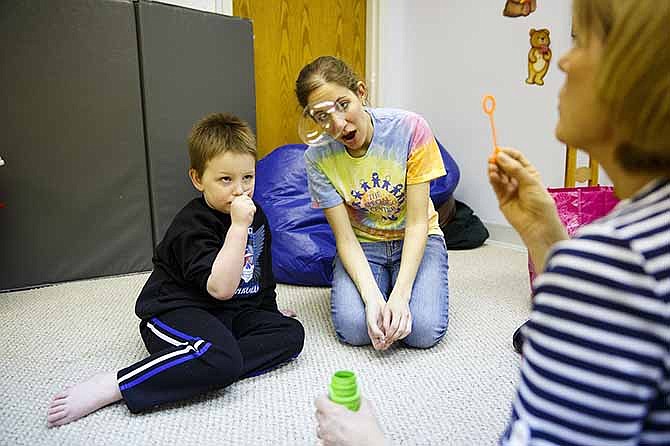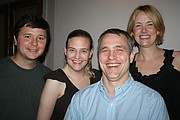James and Heather Brewer dream about the day they can communicate with their son Maddox.
"It would be nice for him to be able to tell us what is wrong," James said. "It'd be nice to know what he's thinking, what he wants."
Now 4, Maddox was diagnosed with autism at 2 1/2 years old. His only communication is the sign for "more.'
Autism is a developmental disability that can cause significant social, communication and behavioral challenges, according to the Centers for Disease Control and Prevention (CDC).
A recent CDC study estimates that 1 in 68 U.S. children are affected by autism or related disorders - up from the previous estimate of 1 in 88 U.S. children.
"It scares me to think that we're not getting any closer to figuring out why the incidence is more prevalent," said Mary Beth Hoey, Maddox's early childhood special education teacher at the Special Learning Center (SLC) in Jefferson City.
She's taught at the SLC - an early childhood development center - for 28 years and sees the potential in children with autism or other developmental disorders.
"They're really cool people," she said. "They have a lot locked in their minds. If we can learn to interact well, they can actually teach us."
She believes observation could be a huge breakthrough for autism research.
"We need to be really good observers to see what we can change in their environments to make them happier," she said. "My hope for kids is that they can find some reasons as to why this is occurring and that we can stop some of it."
Dr. Sarah Gordon - a pediatrician at Jefferson City Medical Group - said better identification of autism and increased awareness could be the reasoning for increased prevalence of the disorder.
"Sometimes people think that periodic well-child visits (to the pediatrician) are for shots, but they're all about growth and development," she said. "The development process is one thing we screen for."
She said the gender and ethnic differences found by the CDC's study are striking to her.
The study found that autism's "estimated prevalence among white children was significantly greater than that among black and Hispanic children."
"This makes me suspect there could be genetic markers," Gordon said.
Janine Stichter, a professor in the Department of Special Education at the University of Missouri's College of Education, believes the CDC study's findings represent no change in a new epidemic.
"I think the increase is a better estimate than we had before," she said. "It's a better representation of what's going on."
Stichter is part of the faculty at the University of Missouri's Thompson Center for Autism & Neurodevelopmental Disorders. The center's mission is "to improve the lives of individuals and families affected by autism and neurodevelopmental disorders" through "programs that integrate research, clinical service delivery, education and public policy."
The Thompson Center is where Maddox received his diagnosis.
When asked about the future of autism, Stichter said she sees it very much like cancer research.
"We are learning so much more about sub-types of autism and different genes that are affected and different learning styles," she said. "I'm very hopeful about all of the research and energy being put into it."
Gordon hopes the study stimulates discussion and a better understanding of autism.
As for the future of 4-year-old Maddox, James said the family takes it one day at a time.
Maddox has attended the SLC for nearly two years, and while James said some weeks are better than others, he and his wife have noticed a dramatic difference.
"It's a long-term deal, and it's not like something is going to happen over night," James said. "I believe he's going to go to the (H. Kenneth) Kirchner State School. He's taken the test, and we've taken a tour there already."
The school teaches only special needs children.
"That's going to be good for him," James said.


